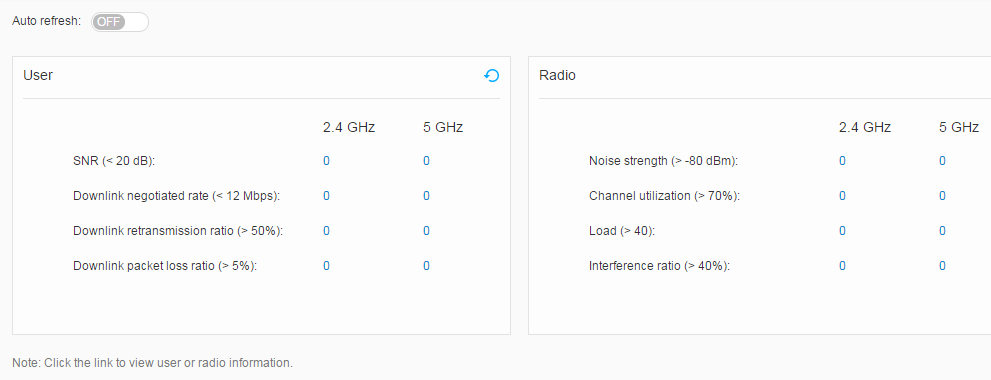Potential Risk
Context
You can view and analyze statistics on exceptions of STAs and radios so that you can identify potential risks.
Procedure
- View potential risks of STAs.
Choose . The Potential Risk page is displayed.

Click the number next to a condition in the User area. The details about abnormal users are displayed in the Wireless User List at the lower part of the page.

Table 1 Statistics on an abnormal user Parameter
Description
User Name
Name of the user.
MAC Address
MAC address of the STA.
AP ID
ID of the AP that the STA associates with.
AP Name
Name of the AP that the STA associates with.
AP Group
AP group to which the AP belongs.
IP Address
IP address of the STA.
SSID
SSID that the STA associates with.
Frequency Band
Frequency band used by the STA to associate with the AP.
STA HT Mode
Current radio mode of the STA.
Authentication Mode
Authentication mode used by the STA to go online.
VLAN
VLAN for data services of the STA.
RSSI
Strength of RF signals received by the STA.
Negotiation Rate
Negotiated rate of the STA.
Throughput
Valid throughput of the STA.
SNR
Uplink SNR of the STA.
Channel
Channel used by the STA.
Channel Usage
Channel usage for service data of the STA.
Frame Quantity
Number of frames of service data of the STA.
Downlink Retransmission Ratio
Retransmission ratio of service data of the STA.
Downlink Packet Loss Ratio
Packet loss ratio of service data of the STA.
- Intelligently diagnose STA access faults.
Select a user in Wireless User List at the lower part of the page and click Intelligent Diagnosis to diagnose login failures, disconnection, and slow service rate or unavailable service transmission. The web platform will provide handling suggestions. For details, see Intelligent Diagnosis.
- Export the wireless user list.
Click Export in the Wireless User List area. The wireless user list is exported in a .csv file.
- View potential risks of radios.
- Choose . The Potential Risk page is displayed.
- Click the number next to a condition in the Radio area. The details about abnormal radios are displayed in Radio List at the lower part of the page.

Table 2 Statistics on an abnormal radio Parameter
Description
AP ID
ID of the AP.
AP Name
Name of the AP.
Radio ID
Radio ID of the AP.
Frequency Band
Frequency band on which a radio works.
STA HT Mode
Radio type.
Status
Radio status.
Working Mode
Radio working mode.
Channel
Working channel of a radio.
Frequency Bandwidth
Channel bandwidth of a radio.
EIRP/Max EIRP(dBm)
Radio power configured/Maximum power in compliance with local laws and regulations.
Access STA
Number of STAs associated with a radio.
Noise Strength
Radio noise level.
Channel Usage
Channel usage of a radio.
Rate
Radio rate.
Total Frame Quantity
Total number of frames received and sent by a radio.
Downlink Retransmission Ratio
Retransmission ratio on a radio.
Downlink Packet Loss Ratio
Packet loss ratio on a radio.
- Intelligently diagnose radio faults.
Select a user or radio to diagnose Mesh link faults, AP failures, and AP upgrade failures. The web platform will provide handling suggestions. For details, see Intelligent Diagnosis.
- Implement spectrum analysis.
Select a radio from Radio List and click Spectrum Analysis. The spectrum charts of the radio are displayed. For details, see Spectrum Analysis.
- Export the radio list.
Click Export in the Radio List area. The radio list is exported in a .csv file.